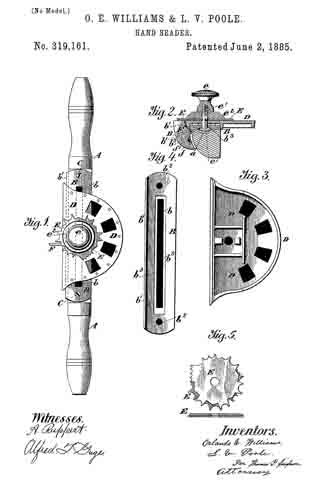
| PLEASE NOTE: The images presented on this page are of low resolution and, as a result, will not print out very well. If you wish to have higher resolution files then you may purchase them for only $2.95 per patent by using the "Buy Now" button below. All purchases are via PayPal. These files have all been cleaned up and digitally enhanced and are therefore suitable for printing, publication or framing. Each zip package contains all the images below (some packages may contain more), and purchased files can be downloaded immediately. |
UNITED STATES PATENT OFFICE.
_________________
ORLANDO E. WILLIAMS AND LAWRENCE V. POOLE, OF WINDSOR, VT.
HAND-BEADER.
_________________
SPECIFICATION forming part of Letters Patent No. 319,161, dated June 2, 1885.
Application filed March 28, 1885. (No model.)
_________________
To all whom it may concern:
Be it known that we, O. E. WILLIAMS and L. V. POOLE, of Windsor, in the county of Windsor and State of Vermont, have invented an Improved Hand-Beader, of which the following is a specification.
The special object of the invention is to make the tool and holder conveniently adjustable to either side of a stationary guide, so that it may be adapted to suit the grain of the wood and make central beadings in thick boards. This object is accomplished by constructing and combining the parts of a header, as hereinafter described.
Figure 1 of the drawings is a plan view; Fig. 2, a central cross-section; Fig. 3, a detail view of the cutter plate or holder, and Fig. 4 a detail view of the guide-piece. Fig. 5 shows a combination of cutters.
In the drawings, A represents the two-handed stock provided with the longitudinal groove a; B, the cutter plate holder having the longitudinal slot b to be arranged over the groove a. It also has a downwardly-extending flange, b’, to prevent lateral displacement and holes b2 b2 near the ends, so as to be secured to the stock by clamp-screws C C.
D is the cutter-plate, and E the cutter-disk, the latter clamped to the former by the thumb-nut e, headed screw e’, and washer e2. The screw e’ is passed with its point up through the slot D, while the opposite parallel sides of its head are within the groove and rest upon the ledges b3 b3. Thus it will be seen that the screw is locked so that it cannot turn, but can be slid along when the nut is loosened.
F is the guide, which is provided with a right-angled arm, f that is held by a screw, f’, to the stock A.
By loosening the nut e the cutter-disk and cutter-plate may be slid so as to bring the beader-points on either side of the guide F, as may be desired.
Having thus described all that is necessary to a full understanding of our invention, what we claim as new, and desire to protect by Letters Patent, is —
A hand-beader having a stock or handle that has a longitudinal groove in its upper side, a fixed guide secured near the center of stock on the front of it, a metal plate secured to the stock on its upper side and having a longitudinal slot corresponding with the groove in the stock and fitting over it, a screw with its head resting loosely in said groove and under said plate with its shank passing up through the slot in the plate, a cutter-plate and a cutting-disk resting successively above said metal plate, each having an opening to receive the shank of the screw, and a thumb-nut engaging the end of the screw, whereby the clamps may be so adjusted as to bring the beading-points on either side of the guide, as set forth.
ORLANDO E. WILLIAMS.
LAWRENCE V. POOLE.
Witnesses:
HUGH GILGHRIST,
H. M. HUBBARD.


